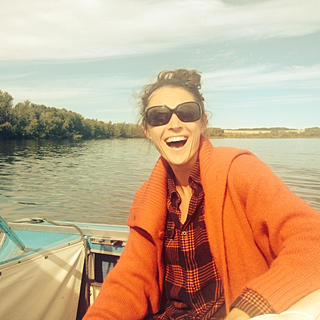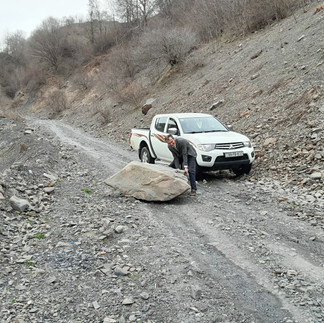Faces of the ECF | Khayyam Ismayil
- Carmen Kuntz
- Jan 23, 2023
- 6 min read
Updated: Jan 27, 2023
Khayyam Ismayil
ECF National Coordinator Azerbaijan
Faces of the Eco-Corridors Fund is a series of stories that provides insight into the people behind the programme. It gives a face to the work ECF is doing in the Caucasus - from office buildings to remote villages and everywhere in between. These are the stories of the people who are implementing the ECF’s unique approach to nature conservation, where local land-use and traditional practices overlap with connecting protected areas and enhancing ecological sustainability. A partnership for living landscapes.
Education: I studied Journalism and English and have a Bachelor of Science (BSc) degree from Khazar University in Baku, Azerbaijan. I also have a Master of Business Administration (MBA) at Alexander Technological Educational Institution of Thessaloniki in Thessaloniki, Greece.
Hometown: My hometown is a village called Nagdali in the Lachin District of south-western Azerbaijan, and I currently live in Baku.
Professional Experience: Before the Eco-Corridors Fund (ECF) project I was the project coordinator at an almond producing company in Azerbaijan where I established cooperation with almond producers from different regions of the country. However, my experience as a project manager predominantly comes from rural development projects in Azerbaijan. In the past I have worked as a project manager for SOS Children's Villages Azerbaijan, an international non-governmental development organization focused on supporting children without parental care and families at risk. I have also worked for an EU-funded project, called Socio-Economic Empowerment and Development of Small-Scale (SEEDS), which focused on working with vulnerable rural families in the regions of Dashkasan, Goranboy and Samukh of Azerbaijan. In this position I was responsible for the overall direction and management of the project. This included daily coordination and monitoring project activities to ensure proper implementation of the project. I was responsible for project proposals and grant agreements, as well as managing project staff and resources. I was involved with all levels of stakeholder relations and prepared progress reports for our donor organizations. I feel this position prepared me well for my work with the ECF.
About Khayyam: I enjoy spending my spare time with my family and friends. Additionally, I like skiing, hiking and spending time in the Eastern Greater Caucasus, specifically skiing at Shahdag Mountain Resort in the Gusar region of the country, or at Tufandag Mountain Resort in Gabala region.
In your eyes, what does the landscape in Azerbaijan look like? Azerbaijan has always been known for its wide variety of landscapes. For me, it is this diversity of landscapes and physical features that illustrate the country. For example, we have the Caspian Sea, whose shoreline forms a natural boundary to the east. Then there are the Greater Caucasus Mountain range to the north. And the extensive flatlands at the country's center. Azerbaijan is also defined by its three mountain ranges; the Greater and Lesser Caucasus, and the Talysh Mountains. Additionally, two major rivers, the Kur and Araz, run through the Kura-Aras Lowland and flow directly into the Caspian Sea. Considering all these physical features, I would say our country is rich with natural resources and includes everything needed for human survival.
“Humans can sustain their existence only by protecting the environment. We are a part of nature and it is impossible to imagine our lives apart from it.” - Khayyam Ismayil
And what does nature in Azerbaijan mean to you? I enjoy the nature of Azerbaijan because, aside from the relaxing scenery, it allows me to connect with the Earth. Azerbaijan is the kind of place where you can spend hot summer and cold winter days in the bosom of nature. Which means you can enjoy the sea, summer camps or just wildlife in summer. On the other hand, you can go skiing in the Caucasus Mountains in winter. I feel Azerbaijan is one of the best places in the world to live.
Humans can sustain their existence only by protecting the environment. We are a part of nature and it is impossible to imagine our lives apart from it. Therefore, every individual should protect and take care of the nature of his homeland. In my opinion, protecting the environment for future generations is a moral obligation for each individual.
As an ECF National Coordinator, what are some of your duties and responsibilities? Similar to the previous projects I have worked on, my ECF duties cover the coordination of the programme activities. This includes communicating and coordinating with all relevant stakeholders, including beneficiaries, communities, local governments and NGOs. During the implementation of activities, it is important to create clear communication with different stakeholders. I would say a large portion of my time is spent on communication.
Another element of the successful implementation of the activities in the community is to build good relationships and generate trust with locals. If you build strong and honest relationships, you will be much more successful at the community level. The rest of the success depends on finding the appropriate people to carry out the activities and implementation of the project in each community. Many of the villagers in the communities in Azerbaijan where ECF operates are involved in some type of farming. In this case, my basic knowledge and experience in the agriculture sector has proved to be an asset as it can help to be accepted as a part of a community by the villagers.

What is the current status of the ECF Project in Azerbaijan?
We are working with a team of experts to update the maps of habitats of key species and key biodiversity areas in the Greater Caucasus Eco-Corridor in Azerbaijan. The main purpose of this is to determine the geographic scope of the corridor and to set the conservation objectives and intervention priorities within the corridor. Habitat suitability models were already conducted for five target species: Eastern tur, Caucasian red deer, Caucasian chamois, brown bear and lynx. Key environmental and human variables will be identified for each species and Maxent software (software used for modeling species niches and distributions), will be used for species suitability modeling.
How many Conservation Agreements have been signed in Azerbaijan?
In the first phase of the ECF project, three Conservation Agreements were signed in Azerbaijan.
What are some of the upcoming ECF Azerbaijan events?
We have a meeting of the ECF Management Board on January, 2023 in Batumi, Georgia. And we plan to start the FPA process in the target communities early in 2023.
What does ECF look like on the ground in Azerbaijan - are there any exciting developments or new accomplishments?
One story that illustrates ECF on the ground in Azerbaijan, is that of the road improvements in the village of Gonaghkend. Prior to ECF’s involvement, the road into the village was in a bad condition and the population of the village was decreasing. ECF got involved in the region because of the presence of key species like eastern tur, Caucasian red deer and Caucasian chamois. There was a formal ceremony for the signing of the Conservation Agreement in 2018. Many important guests attended the signing ceremony, which took place at the Gonaghkend Municipality office where the community-based organization (Gonaghkend Tebiet Dostlari) signed the ECF Conservation Agreement. The guests included the Governor of the District of Guba, the German Ambassador, involved partner organizations like the Municipality of Gonaghkend, and local institutions from the Ministry of Ecology and Natural Resources of Azerbaijan.
After this ceremony, as ECF was underway in the community, the road to the village was improved with funds from the Azerbaijan government, including the construction of two bridges. The community then observed population growth in the village, as well as an increase in the number of tourists visiting the village. With the improvement of road infrastructure, the social and economic life of the rural population has changed positively. And since the road was restored, a gas supply to the village was also completed in 2020 and as a result, the use of wood as fuel by the rural population has decreased. This specific example illustrates ECF’s involvement in improving livelihoods and socio-economic well-being, while simultaneously protecting nature.
In your opinion, why is ECF effective? How does it work towards the conservation of nature and also economic improvements?
In my opinion, one of the main reasons why ECF is effective is the use of the Financial Participatory Approach (FPA) tool in communities. This approach plays a major role in establishing strong relationships with community members. The FPA supports collective learning about innovative practices while simultaneously building mutual trust in the communities. Conservation Agreements are also an aspect of ECF that makes the project effective. Conservation Agreements support communities by providing them with long-term financial aid. They involve the establishment of sustainable land-use plans and support community-based natural resources management, thus improving the socio-economic situation of communities in these corridors.
Khayyam is the newest member of the ECF team and started with the project in early 2022. He brings a diverse set of skills to the ECF team including project management skills and experience with rural development and socio-economic empowerment projects, which are all welcomed asset














































